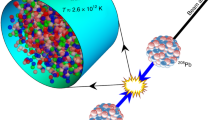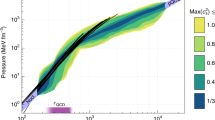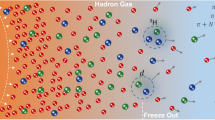Abstract
High-energy collisions between heavy nuclei have in the past 20 years provided multiple indications of a deconfined phase of matter that exists at phenomenally high temperatures and pressures. This 'quark–gluon plasma' is thought to have permeated the first microseconds of the Universe. Experiments at the Large Hadron Collider should consolidate the evidence for this exotic medium's existence, and allow its properties to be characterized.
This is a preview of subscription content, access via your institution
Access options
Subscribe to this journal
Receive 51 print issues and online access
$199.00 per year
only $3.90 per issue
Buy this article
- Purchase on Springer Link
- Instant access to full article PDF
Prices may be subject to local taxes which are calculated during checkout






Similar content being viewed by others
References
Gross, D. J. & Wilczek, F. Ultraviolet behavior of non-abelian gauge theories. Phys. Rev. Lett. 30, 1343–1346 (1973).
Politzer, H. J. Reliable perturbative results for strong interactions? Phys. Rev. Lett. 30, 1346–1349 (1973).
Cabibbo, N. & Parisi, G. Exponential hadronic spectrum and quark liberation. Phys. Lett. B 59, 67–69 (1975).
Collins, J. C. & Perry, M. J. Superdense matter: neutrons or asymptotically free quarks? Phys. Rev. Lett. 34, 1353–1356 (1975).
Hagedorn, R. Statistical thermodynamics of strong interactions at high energies. Nuovo Cimento Suppl. 3, 147–186 (1965).
Karsch, F., Laermann, E. & Peikert, A. Quark mass and flavour dependence of the QCD phase transition. Nucl. Phys. B 605, 579–599 (2001).
Aoki, A., Fodor, Z., Katz, S. D. & Szabo, K. K. The QCD transition temperature: results with physical masses in the continuum limit. Phys. Lett B. 643, 46–54 (2006).
Fodor, Z. & Katz, S. Critical point of QCD at finite T and µ, lattice results for physical quark masses. J. High Energy Phys. 4, 050 (2004).
Allton, C. R. et al. The QCD thermal phase transition in the presence of a small chemical potential. Preprint at <http://arxiv.org/abs/hep-lat/0204010> (2002).
Ejiri, S. et al. Study of QCD thermodynamics at finite density by Taylor expansion. Preprint at <http://arxiv.org/abs/hep-lat/0312006> (2003).
CERN. New state of matter created at CERN. <http://press.web.cern.ch/press/PressReleases/Releases2000/PR01.00EQuarkGluonMatter.html> (2000).
Heinz, U. & Jacob, M. Evidence for a new state of matter: an assessment of the results from the CERN lead beam programme. Preprint at <http://arxiv.org/abs/nucl-th/0002042> (2000).
Arsene, I. et al. Quark–gluon plasma and color glass condensate at RHIC? The perspective from the BRAHMS experiment. Nucl. Phys. A 757, 1–27 (2005).
Back, B. B. et al. The PHOBOS perspective on discoveries at RHIC. Nucl. Phys. A 757, 28–101 (2005).
Adams, J. et al. Experimental and theoretical challenges in the search for the quark–gluon plasma: the STAR Collaboration's critical assessment of the evidence from RHIC collisions. Nucl. Phys. A 757, 102–183 (2005).
Adcox, K. et al. Formation of dense partonic matter in relativistic nucleus–nucleus collisions at RHIC: experimental evaluation by the PHENIX Collaboration. Nucl. Phys. A 757, 184–283 (2005).
Csörgö, T., Dávid, G., Lévai. P. & Papp, G. (eds) Quark matter 2005 — proceedings of the 18th international conference on ultra-relativistic nucleus–nucleus collisions. Nucl. Phys. A 774, 1–968 (2006).
Andronic, A., Braun-Munzinger, P. & Stachel, J. Hadron production in central nucleus–nucleus collisions at chemical freeze-out. Nucl. Phys. A 772, 167–199 (2006).
Becattini, B., Gadzicki, M., Keranen, A., Manninen, J. & Stock, R. Chemical equilibrium study in nucleus–nucleus collisions at relativistic energies. Phys. Rev. C 69, 024905 (2004).
Braun-Munzinger, P., Redlich, K. & Stachel, J. in Quark–Gluon Plasma 3 (eds Hwa, R. C. & Wang, X. N.), 491–599 (World Scientific, Singapore, 2004).
Braun-Munzinger, P. & Stachel, J. Probing the phase boundary between hadronic matter and the quark-gluon plasma in relativistic heavy-ion collisions. Nucl. Phys. A 606, 320–328 (1996).
Braun-Munzinger, P., Stachel, J. & Wetterich, C. Chemical freeze-out and the QCD phase transition temperature. Phys. Lett. B. 596, 61–69 (2004).
Stock, R. The parton to hadron phase transition observed in Pb+Pb collisions at 158 GeV per nucleon. Phys. Lett. B 456, 277–282 (1999).
Heinz, U. Hadronic observables: theoretical highlights. Nucl. Phys. A 638, c357–364 (1998).
Aoki, Y., Fodor, Z., Katz, S. D. & Szabo, K. K. The order of the quantum chromodynamics transition predicted by the standard model of particle physics. Nature 443, 675–678 (2006).
Gyulassy, M. & McLerran, L. New forms of QCD matter discovered at RHIC. Nucl. Phys. A 750, 30–63 (2005).
Baier, R. & Romatschke, P. Causal viscous hydrodynamics for central heavy-ion collisions. Preprint at <http://arxiv.org/abs/nucl-th/0610108> (2006).
Romatschke, P. Causal viscous hydrodynamics for central heavy-ion collisions II: meson spectra and HBT radii. Preprint at <http://arxiv.org/nucl-th/0701032> (2007).
Heinz, U., Song, H. & Chaudhuri, A. K. Dissipative hydrodynamics for viscous relativistic fluids. Phys. Rev. C 73, 034904 (2006).
Bhalerao, R. S., Blaizot, J. P., Borghini, N. & Ollitrault, J. Y. Elliptic flow and incomplete equilibration at RHIC. Phys. Lett. B 627, 49–54 (2005).
Bjorken, J. D. Fermilab-PUB-82-59-THY (1982) and erratum (unpublished).
Wang, X. N. & Gyulassy, M. Gluon shadowing and jet quenching in A+A collisions at √s = 200A GeV. Phys. Rev. Lett. 68, 1480–1483 (1992).
Baier, H., Dokshitzer, Y. L., Mueller, A. H., Peigne, S. & Schiff, D. Radiative energy loss of high energy quarks and gluons in a finite-volume quark-gluon plasma. Nucl. Phys. B 483, 291–320 (1997).
Baier, H., Dokshitzer, Y. L., Mueller, A. H., Peigne, S. & Schiff, D. Radiative energy loss and p⊥-broadening of high energy partons in nuclei. Nucl. Phys. B 484, 265–282 (1997).
d'Enterria, D. Quantum chromo (many-body) dynamics probed in the hard sector at RHIC. Preprint at <http://arxiv.org/abs/nucl-ex/0406012> (2004).
Bjorken, J. D. Highly relativistic nucleus–nucleus collisions: the central rapidity region. Phys. Rev. D 27, 140–151 (1983).
Adler, S. S. et al. (PHENIX collaboration). A detailed study of high-pT neutral pion suppression and azimuthal anisotropy in Au+Au Collisions at √S NN = 200 GeV. Preprint at <http://arxiv.org/abs/nucl-ex/0611007> (2006).
Mischke, A. (for the STAR collaboration). High-pT hadron production and triggered particle correlations. Preprint at <http://arxiv.org/abs/nucl-ex/0605031> (2006).
Adamova, D. et al. (CERES collaboration). Semihard scattering unraveled from collective dynamics by two-pion azimuthal correlations in 158A GeV/c Pb+Au collisions. Phys. Rev. Lett. 92, 032301 (2004).
Ploskon, M. (for the CERES collaboration). Two particle azimuthal correlations at high transverse momentum in Pb–Au at 158 A GeV/c. Preprint at <http://arxiv.org/abs/nucl-ex/0701023> (2007).
Stöcker, H. Collective flow signals the quark–gluon plasma. Nucl. Phys. A 750, 121–147 (2005).
Casalderrey-Solana, J., Shuryak, E. & Teaney, D. Conical flow induced by quenched QCD jets. Preprint at <http://arxiv.org/abs/hep-ph/0411315> (2004).
Adare, A. et al. (the PHENIX collaboration). Energy loss and flow of heavy quarks in Au+Au collisions at √S NN = 200 GeV. Preprint at <http://arxiv.org/abs/nucl-ex/0611018> (2006).
Zhang, H. et al. Heavy flavour production at STAR. J. Phys. G 32, S29–S34 (2006).
Zapp, K., Ingelman, G., Rathmans, J. & Stachel, J. Jet quenching from soft QCD scattering in the quark–gluon plasma. Phys. Lett. B. 637, 179–184 (2006).
Adil, A., Gyulassy, M., Horowitz, W. A. & Wicks, S. Collisional energy loss of non asymptotic jets in a QGP. Preprint at <http://arxiv.org/abs/nucl-th/0606010> (2006).
Vitev, I. Contribution to CERN yellow report on hard probes in heavy ion collisions at the LHC. Preprint at <http://arxiv.org/abs/hep-ph/0310274> (2003).
Satz, H. & Matsui, T. J/Ψ suppression by quark-gluon plasma formation. Phys. Lett. B 178, 416–422 (1986).
Abreu. M. C. et al. Transverse momentum distributions of J/Ψ, Ψ´. Drell–Yan and continuum dimuons produced in Pb–Pb interactions at the SPS. Phys. Lett. B 499, 85–96 (2001).
Capella, A., Kaidalov, A. B. & Sousa, D. Why is the J/Ψ suppression enhanced at large transverse energy? Phys. Rev. C 65, 054908 (2002).
Braun-Munzinger, P. & Stachel, J. (Non)thermal aspects of charmonium production and a new look at J/Ψ suppression Phys. Lett. B 490, 196–202 (2000).
Braun-Munzinger, P. & Stachel, J. On charm production near the phase boundary. Nucl. Phys. A 690, 119–126 (2001).
Thews, R. L., Schroedter, M. & Rafelski, J. Enhanced J/Ψ production in deconfined quark matter. Phys. Rev. C 63, 054905 (2001).
Andronic, A., Braun-Munzinger, P., Redlich, K. & Stachel, J. Statistical hadronization of heavy quarks in ultra-relativistic nucleus–nucleus collisions. Nucl. Phys. A. Preprint at <http://arxiv.org/abs/nucl-th/0611023> (2006).
Andronic, A., Braun-Munzinger, P., Redlich, K. & Stachel, J. Evidence for charmonium generation at the phase boundary in ultra-relativistic nuclear collisions Phys. Lett. B. Preprint at <http://arxiv.org/abs/nucl-th/0701079> (2007).
Barrette, J. et al. Observation of anisotropic event shapes and transverse flow in Au–Au collisions at AGS energy. Phys. Rev. Lett. 73, 2532–2536 (1994).
Voloshin, S. & Zhang, Y. C. Flow study in relativistic nuclear collisions by Fourier expansion of azimuthal particle distributions. Z. Phys. C 70, 665–671 (2007).
Poskanzer, A. M & Voloshin, S. A. Methods for analyzing anisotropic flow in relativistic nuclear collisions. Phys. Rev. C58, 1671–1678 (1998).
Huovinen, P. et al. Radial and elliptic flow at RHIC: further predictions. Phys. Lett. B 503, 58–64 (2001).
Teaney, D., Lauret, J. & Shuryak, E. A hydrodynamic description of heavy ion collisions at the SPS and RHIC. Preprint at <http://arxiv.org/abs/nucl-th/0110037> (2001).
Kolb, P. & Heinz, U. in Quark–Gluon Plasma 3 (eds Hwa, R. C. & Wang, X. N.) 634–714 (World Scientific, Singapore, 2004).
Adams, J. et al. (the STAR collaboration). Azimuthal anisotropy in Au+Au collisions at √S NN = 200 GeV. Phys. Rev. C72 014904 (2005).
Vitev, I. Jet quenching in relativistic heavy ion collisions J. Phys. G. Preprint at <http://arxiv.org/abs/hep-ph/0503221> (2005).
Akiba, Y. Probing the properties of dense partonic matter at RHIC. Nucl. Phys. A 774, 403–408 (2006).
Kolb, P. & Heinz, U. in Quark–Gluon Plasma 3 (eds Hwa, R. C. & Wang, X. N.) 1–59 (World Scientific, Singapore, 2004).
Adare, A. et al. (PHENIX collaboration). J/Ψ production vs centrality, transverse momentum, and rapidity in Au+Au collisions at √S NN = 200 GeV. Preprint at <http://arxiv.org/abs/nucl-ex/0611020> (2006).
Author information
Authors and Affiliations
Ethics declarations
Competing interests
The authors declare no competing financial interests.
Additional information
Reprints and permissions information is available at npg.nature.com/reprintsandpermissions.
Correspondence should be addressed to J.S. (stachel@physi.uni-heidelberg.de).
Rights and permissions
About this article
Cite this article
Braun-Munzinger, P., Stachel, J. The quest for the quark–gluon plasma. Nature 448, 302–309 (2007). https://doi.org/10.1038/nature06080
Published:
Issue Date:
DOI: https://doi.org/10.1038/nature06080
This article is cited by
-
Classifier for centrality determination with zero-degree calorimeter at the cooling-storage-ring external-target experiment
Nuclear Science and Techniques (2023)
-
Event plane determination from the zero degree calorimeter at the cooling storage ring external-target experiment
Nuclear Science and Techniques (2023)
-
Measurement of electrons from open heavy-flavor hadron decays in Au+Au collisions at \( \sqrt{s_{\textrm{NN}}} \) = 200 GeV with the STAR detector
Journal of High Energy Physics (2023)
-
A large-N expansion for minimum bias
Journal of High Energy Physics (2021)
-
The multiple-charm hierarchy in the statistical hadronization model
Journal of High Energy Physics (2021)
Comments
By submitting a comment you agree to abide by our Terms and Community Guidelines. If you find something abusive or that does not comply with our terms or guidelines please flag it as inappropriate.



